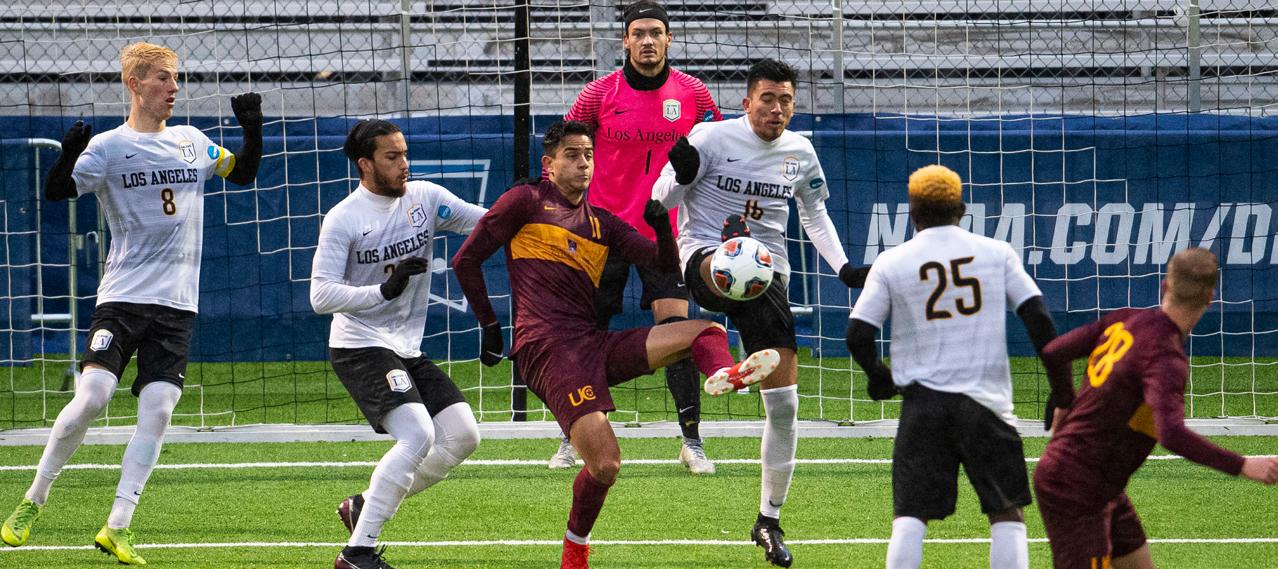
13 minute read
Time Management
transcripts
After completing four semesters of high school, ask your school counselor to upload an official transcript to your NCAA Eligibility Center account. If you have attended more than one high school or took courses from more than one program, the Eligibility Center needs an official transcript from all high school(s) or program(s) you attended. You will also need to ask your school counselor to send your final transcript with proof of graduation once you have completed high school. Please note: The NCAA Eligibility Center does not accept grades from one high school or program transcribed on another high school’s transcript.
Advertisement
High schools have the capability to upload transcripts directly to a student’s account for free from the High School Portal. As with other electronic transcript providers, this process is much quicker than using the U.S. Postal Service or any overnight delivery method. Students should contact their school counselor to ask for their transcript to be uploaded or sent electronically through one of the approved e-transcript providers listed below: • National Transcript Center. • Parchment. • Scrip-Safe/Credentials. • Scribbles Software. • USMO ET.
REMEMBER
If you have attended more than one high school or took courses from more than one program, the NCAA
Eligibility Center needs an official transcript from ALL high schools or programs. A state high school equivalency test (e.g., General Educational Development) may be accepted as proof of graduation under certain conditions, but it will not satisfy requirements for core courses, GPA or SAT/ACT scores. The equivalency test may be accepted as proof of graduation if taken after the graduation date of your class and before • XAP. • Naviance. • State of Georgia: DIRECT. • Cialfo. In order to send a transcript by U.S. mail or through an overnight or express delivery service, please use the appropriate address on page 1. • International students: For information on proper submission procedures for transcripts and academic records, see page 29 or visit ncaa.org/international.
Note: Some approved programs that have a list of NCAAapproved courses are not credit-awarding institutions and, therefore, do not produce official transcripts. If you attend an approved program that does not award credit, a grade
equivalency tests/diplomas
report from the program should be submitted. full-time enrollment into any college or university. You will need to mail an official copy of the applicable certificate along with your state high school equivalency test scores to the NCAA Eligibility Center. You can contact your state education agency to request the certificate and test scores to be sent to the NCAA Eligibility Center.
what is a core course?
NCAA schools require college-bound student-athletes to build a foundation of high school courses (core courses) to prepare them for the academic expectations in college.
For a high school class to be an NCAA-approved core course, it must meet these conditions: 1.
2.
3. Be a four-year college preparatory course in one of these subject areas: • English. • Math (Algebra I or higher). • Natural/physical science. • Social science. • Foreign language. • Comparative religion or philosophy. Be taught at or above your high school’s regular academic level.
Receive credit toward high school graduation and appear on an official transcript with course title, grade and credit awarded.
Approved classes are added to your school’s list of NCAAapproved core courses. Make sure you are taking courses on the approved list; ask your counselor if you need help.
What is Not a Core Course
Not all high school classes are NCAA-approved core courses. Some examples of courses that are not NCAA- approved core courses include: • Courses in non-core areas, such as driver education, typing, art, music, physical education or welding. • Courses that prepare students for the world of work or life, or for a two-year college or technical school, such as personal finance, consumer education or tech prep. • Courses taught below grade level, at a slower pace or with less rigor or depth, such as basic, essential, fundamental or foundational courses.
• Credit-by-exam courses.
Core-Course Credits
You can earn credit for a core course only once. If you take a course that repeats the content of another core course, you earn credit for only one of these courses and the higher grade counts toward your core-course GPA. For more information on core-course credits, visit ncaa.org/studentathletes/future/core-courses.
Courses Taken Before High School
If you take a high school class such as Algebra I or Spanish I in eighth grade, the class may count toward your 16 core courses if it appears on your high school’s list of NCAAapproved core courses and is shown on your high school transcript with grade and credit.
Courses Taken After High School
For information about courses taken after high school, see page 20 for Division I or page 23 for Division II.
College Courses, Dual-Enrollment Courses and Dual-Credit Courses
College courses may be used to satisfy NCAA corecourse requirements if the courses are awarded a grade and credit by the high school for any student and meet all other requirements for core courses. College courses must be placed on the student’s high school transcript with clarification of college completion.
REMEMBER


nontraditional and online courses
Nontraditional courses are taught online or through distance learning, hybrid/blended, independent study, individualized instruction, correspondence or similar means.
Generally, for a nontraditional course to count as an NCAA-approved core course, it must meet all of the following requirements: • The course must meet all requirements for an NCAAapproved core course. • All students in the course must have regular instructorled interaction for the purpose of instruction, evaluation and assistance for the duration of the course. This may include, for example, exchanging emails between the student and teacher, online chats, phone calls, feedback on assignments and the opportunity for the teacher to engage the student in individual or group instruction. • The course must have a defined time period for completion. For example, it should be clear how long students are required to be enrolled and working in the course and how long a school would permit a student to work on a single nontraditional course. • Student work (e.g., exams, papers, assignments) must be available for evaluation and validation.
• The course should be clearly identified as nontraditional on the student’s official high school transcript.
REMEMBER
Log in to your NCAA Eligibility Center account frequently to update your school information if you take courses from additional academic programs.

A nontraditional course may not be approved for any of the following reasons: • Does not have teacher-based instruction.
• Does not require regular and ongoing instructor-led interaction between the student and teacher.
• Does not require students to complete the entire course. • Does not prepare students for four-year college class work. • Does not have official student grade records. • Does not meet NCAA core-course requirements. When viewing the school/program’s course list, you will find information about any nontraditional programs or courses in the “Additional Information” box as seen below.
Additional Information
Coursework from this school/program meets NCAA nontraditional core-course legislation.
To find out if a nontraditional program or course is approved, go to
eligibilitycenter.org/courselist
to search the school/program and view the respective additional information boxes.
grade-point average
The NCAA Eligibility Center calculates your core-course grade-point average based on the grades you earn in NCAAapproved core courses. Only your best grades from the required number of NCAA core courses will be used.
Your GPA is calculated on a 4.000 scale. Numeric grades such as 92 or 87 are changed to letter grades such as A or B. As part of this calculation, each grade received is assigned “quality points,” as shown in the scale below. The NCAA Eligibility Center does not use plus or minus grades when calculating your GPA. For example, grades of B+, B and B- advanced placement courses may improve your core-course GPA but your high school must notify the NCAA Eligibility Center that it awards weighted grades in these classes.
In “Pass/Fail” grading situations, the NCAA Eligibility Cenwill each be worth three quality points. Weighted honors or
C = 2 points ter will assign your high school’s lowest passing grade for a course in which you received a “Pass” grade. For most high schools, the lowest passing grade is a D, so the NCAA Eligibility Center generally assigns a D as a passing grade. For Spring/Summer 2020 “Pass/Fail” grades, please see the COVID-19 FAQ.
Calculating Your Quality Points
In order to determine your quality points earned for each course, multiply the quality points for the grade by the amount of credit earned.
Examples:
• An A grade (4 points) for a trimester course (0.34 units): 4 points x 0.34 units = 1.36 total quality points • An A grade (4 points) for a semester course (0.50 units): 4 points x 0.50 units = 2.00 total quality points • An A grade (4 points) for a full-year course (1.00 units): 4 points x 1.00 units = 4.00 quality points
Quality Points
A = 4 points B = 3 points Use the worksheets on pages 21 and 25 to help determine your core-course GPA.
D = 1 point
Units of Credit
1 quarter unit = 0.25 units 1 trimester unit = 0.34 units 1 semester unit = 0.50 units 1 year = 1 unit
College athletics has really shaped my life by giving me a plethora of opportunities to pursue when my athletic career is over. Between the connections that are made with other student athletes, faculty and supporters, the opportunities are endless. Having the ability to get both my bachelor’s degree and my master’s degree, all while playing football, is an experience not many people can attest to. The hard work that has been put in is recognized by employers and sought after in even the biggest companies. Without collegiate athletics, these opportunities wouldn’t be there for me. To say that I am thankful for the NCAA would be an understatement.
Justice Littrell Football, University of Northern Colorado
Division I schools require college-bound student-athletes to meet academic standards for NCAAapproved core courses, core-course GPA and test scores. To be eligible to practice, compete and receive an athletics scholarship in your first full-time year at a Division I school, you must graduate from high school and meet all of the following requirements:
1. Complete a total of 16 core courses in the following areas:
ENGLISH MATH
(Algebra I or higher)
NATURAL/ PHYSICAL
SCIENCE (Including one year of lab, if offered)
ADDITIONAL
(English, math or natural/physical science)
SOCIAL SCIENCE ADDITIONAL COURSES
(Any area listed to the left, foreign language or comparative religion/philosophy)
4 years 3 years 2 years 1 year 2 years 4 years
2. Complete 10 of your 16 core courses, including seven in English, math or natural/physical science, before the start of your seventh semester. Once you begin your seventh semester, any course that is needed to meet the 10/7 requirement cannot be replaced or repeated.
Semester 2 Semester 3 Semester 4 Semester 5 Semester 6 Semester 7
10 of 16 core courses completed before semester 7 (English, math or natural/physical science)
• Students with solely international academic credentials (including Canada) are not required to meet the 10/7 requirement.
Semester 8
The Eligibility Center will use the best combination of courses to meet the 10/7 requirement. Courses can be repeated or replaced so long as they are not needed to meet the 10/7 requirement.
3. Complete the 16 NCAA-approved core courses in eight academic semesters or four consecutive academic years from the start of ninth grade. If you graduate from high school early, you still must meet core-course requirements.
4. Earn an SAT combined score or ACT sum score that matches your core-course GPA (minimum 2.300) on the Division I full-qualifier sliding scale. Review the sliding scale on page 20 to ensure your score meets Division I requirements.
How to plan your high school courses to meet the 16 core-course requirement:
4 x 4 = 16
9th Grade (1) English (1) Math (1) Science (1) Social Science and/or additional
4 core courses
10th Grade (1) English (1) Math (1) Science (1) Social Science and/or additional
4 core courses
11th Grade (1) English (1) Math (1) Science (1) Social Science and/or additional
4 core courses
12 th Grade (1) English (1) Math (1) Science (1) Social Science and/or additional
4 core courses
Academic Certification Decisions
An academic certification will be conducted to determine if you meet the Division I academic standards. Academic certifications are required for all college-bound student-athletes planning to compete at a Division I school. (An amateurism certification is also required; see page 27.) The following items are required in order to complete your academic certification: • A final official transcript with proof of graduation. • No open academic tasks in your Eligibility Center • Official transcripts from all high schools attended. Certification account (see page 11). • Test scores. • Be on a Division I school’s institutional request list. Being placed on a school’s institutional request list notifies the NCAA Eligibility Center to complete an academic evaluation for you after all of your appropriate documents have been submitted.
If you are being recruited by a Division I school, below are the most common decisions you may receive once a certification has been completed.
EARLY ACADEMIC QUALIFIER
If you meet specific criteria after six semesters of high school, you may be deemed an early academic qualifier for Division I and may practice, compete and receive an athletics scholarship during your first year of full-time enrollment. To be an early academic qualifier, you will need: during your first regular academic term
• A minimum SAT combined score (math and critical reading) of 980 or ACT sum score of 75.
• A core-course GPA of 3.000 or higher in a minimum of 14 core courses in the following areas:
• Three years of English.
• Two years of math.
• Two years of science.
• Two additional years of English, math or
• Five additional core courses in any area.
A final high school transcript must be submitted to the NCAA Eligibility Center after high school graduation for all early academic qualifiers.
QUALIFIER
You may practice, compete and receive an athletics scholarship during your first year of full-time enrollment at an NCAA Division I school.
ACADEMIC REDSHIRT
You may receive an athletics scholarship during your first year of full-time enrollment and may practice natural/physical science.
but may NOT compete during your first year of enrollment. You must pass either eight quarter or nine semester hours to practice in the next term.
NONQUALIFIER
You will not be able to practice, compete or receive an athletics scholarship during your first year of enrollment at a Division I school.
What if I Don’t Graduate on Time?
In Division I, if you do not graduate on time (in four years/ eight semesters), the NCAA Eligibility Center will still use your grades and coursework for the first four years/eight semesters for your certification. You will still need to provide proof of graduation (once you graduate) and you may not use any coursework taken after your high school graduation toward your certification.
What if I Don’t Meet the Division I Standards?
If you have not met all of the Division I academic standards, you may not compete in your first year at a Division I college. However, if you qualify as an academic redshirt, you may practice during your first term in college and receive an athletics scholarship for the entire year.
To qualify as an academic redshirt, you must graduate high school and meet all of the following academic standards: • Complete 16 core courses. • Earn an SAT combined score or ACT sum score matching your core-course GPA (minimum 2.000) on the Division I sliding scale (see page 20).






